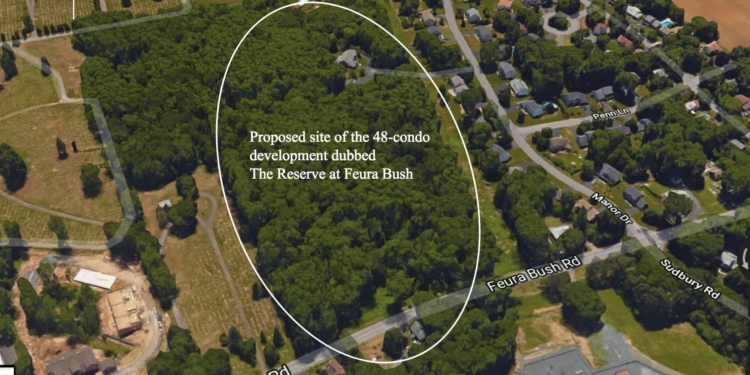BETHLEHEM — Town board members did not vote on whether to approve a rezoning application that would allow for a 48-unit condominium development on Feura Bush road near Glenmont Plaza at their most recent meeting on Wednesday, Nov. 21. According to outgoing Supervisor John Clarkson, it is unlikely that the board will vote on the application this year — if ever.

“There doesn’t seem to be the support for it,” Clarkson said on Monday, Dec. 4. “The developer seems to be willing to make changes, perhaps come back with a single-family proposal sometime next year.”
The project has met with a considerable amount of resistance from neighboring property owners, who have expressed concerns about additional traffic, water levels, local schools, wildlife and more.
Developer Amedore Homes has come before both the Town and Planning Boards on several occasions and endeavored to address each issue raised, yet the application was still opposed by two of five Planning Board members. Plus, it isn’t clear whether the Town Board would have ultimately approved it — this year or next. Supervisor-elect David VanLuven said he feels tripling the amount of units, from the 17 single family homes for which it is now zoned, is simply too much.
Other board members, as well as Director of Planning Rob Leslie, commented on the need for more condominium-style housing in Bethlehem, to accommodate aging residents and younger professionals who might prefer to own condominium-style living situations. They noted that it seems to fit within the current comprehensive plan in that it would diversify the current real estate market in town, while providing housing for an aging population.

Leslie attempted to address concerns raised during the Town Board meeting two weeks earlier. He said that the New York state Department of Transportation (NYSDOT) is aware of the poor condition of Feura Bush Road and is scheduled to resurface it in 2018. He also discussed the possible use of Rectangular Rapid Flashing Beacons (RRFBs) to alert drivers to the presence of pedestrians attempting to cross the road.
Leslie described the RRFB as a strobing light that can be activated by a pedestrian wishing to cross the roadway. “It is by law, required that a motor vehicle yield to a pedestrian in a crosswalk. Most of the time, that law is not obeyed. So, this will send a visual cue to drivers to yield to pedestrians.” He said that there will soon be an RRFB installed at the intersection of Delaware and Oakwood avenues, as a result of the Delaware Avenue Streetscape Project, if residents wish to see what one would look like.
(For the full seven-page response from the Planning Board regarding concerns about the water table, wildlife, roundabouts, local schools and more, please visit this link and view pages 60-66. The Nov. 21 Town Board meeting, in its entirety, can be viewed here.)
Patty Wheeler, of Dover Drive, said she was concerned about the pace of the project and implied that she would prefer to see the application taken up by the board under the next administration. She also criticized the town for its public feedback process, which does not allow for a back-and-forth between residents and project developers, and requires that comments from the public be delivered prior to any presentations from developers.

David Greenwood, of Feura Bush Road, who said he reviewed the town zoning in his area before purchasing property there, argued that the zoning was in place for a reason and that the board had not yet been presented with a compelling reason to change that assignation.
“If you can table any decisions until the new board members have been put on,” he said, “I think that would be a good idea. A lot of the campaigning that was done by the candidates was on the issue of development and whether this town was moving too fast, and I think the people have spoken with who they elected. I think you should make the new board members have a chance to decide this issue.”
Asked whether Amedore would consider building fewer than 48 units on the property, John Bossalini, a project manager with the company, said that, after all considerations, 48 was the company’s “critical mass” to make the development a desirable investment for potential buyers. It costs money, he explained, to provide all the services of a condominium development, such as snow removal and grounds maintenance, that residents pay for “maintenance-free living.” The fewer units, the higher the individual assessment per unit, he explained. “There’s a big difference between 32 and 48.”
Board member Julie Sasso said she didn’t know that tripling the amount of units would triple the amount of people living in the area, as single-family homes tend to have more occupants. She did, however, sympathize with the loss of open green spaces that neighboring landowners have been able to enjoy.
“I don’t see this as being about homes versus condos versus apartments,” said VanLuven. “And it’s not about whether to develop or not develop this property. This property is going to be developed. And it’s going to be developed because we don’t have an open space fund in town, so landowners don’t have an option other than selling their land to a developer if they need to receive some kind of financial compensation for their land.” A fund, he said, would give landowners an option they don’t currently have.
While Board members did not make any decisions on the application, nor about whether they would vote on it in December, Clarkson has since indicated that he will not put the item on the Dec. 13 agenda.



